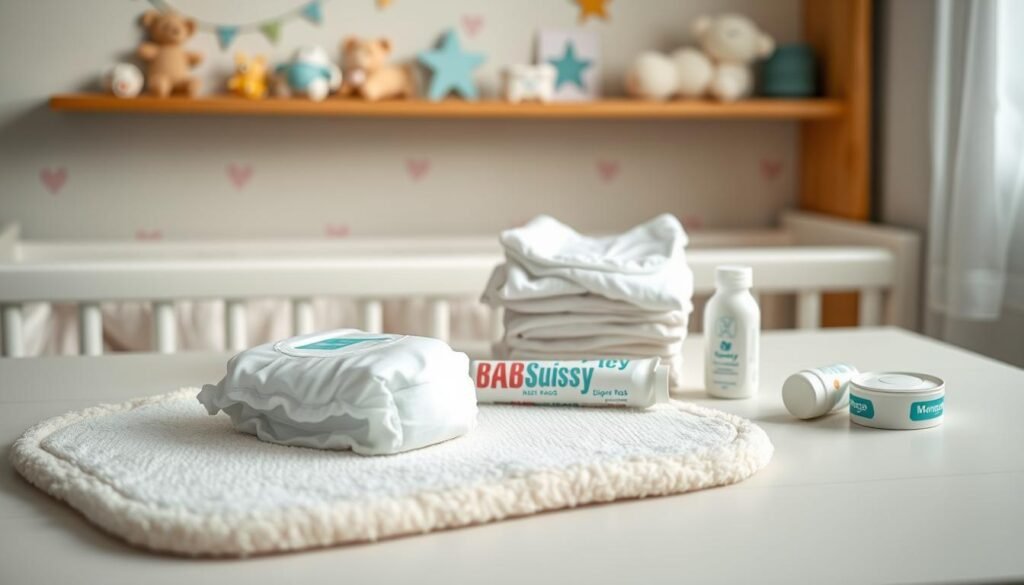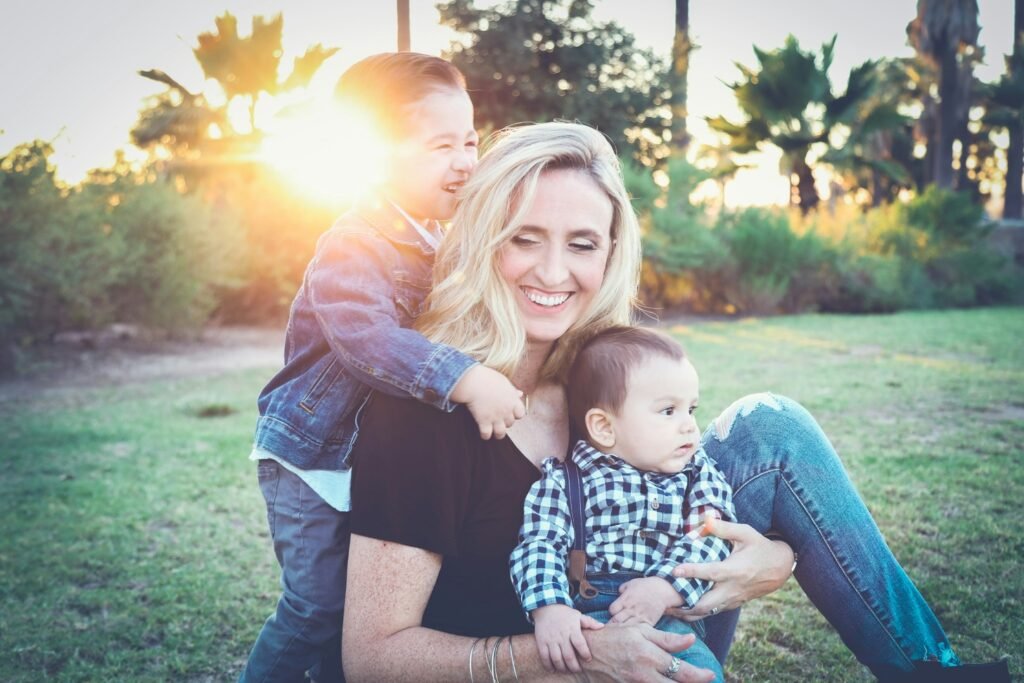Diaper Changing Made Easy: Helpful Advice for Parents

If you’re a parent dealing with tough diaper changes, you’re not alone. Many parents find these moments stressful. But, with the right tips, they can become smoother for both you and your little one.
I’m here to share some tried and true tips to make this daily task easier. We’ll cover the essentials to reduce stress. This way, diaper changing will become a more manageable experience.
You’re about to discover practical hacks that will make this daily routine better. These tips will make a big difference for you and your baby. Let’s dive into the helpful advice.
Understanding the Basics of Diaper Changing
Learning the basics of diaper changing is key to your parenting journey. You’ll change diapers often, as babies use eight to ten diapers a day.
Why Diaper Changing is Important
Diaper changing keeps your baby healthy and clean. A dirty diaper can irritate the skin and cause diaper rash. It also helps avoid infections.
When to Change a Diaper
How often you change diapers depends on your baby’s age and the type of diaper you use.
| Age | Diaper Change Frequency |
|---|---|
| 0-3 months | 8-12 times a day |
| 4-6 months | 6-8 times a day |
| 7-12 months | 4-6 times a day |
Knowing when and why to change diapers is vital. It helps you prepare for this important task. Creating a diaper changing routine can make it easier and less stressful.
Essential Diaper Changing Supplies
Having the right supplies is key to successful diaper changing. As a parent, you might wonder what you need for this task.
Types of Diapers: Cloth vs. Disposable
Choosing between cloth and disposable diapers is a big decision. Both have their good points and downsides.
Cloth diapers are good for the planet and save money over time. They’re also kinder to your baby’s skin. But, they need more work to clean and care for.
Disposable diapers are easy to use and come in many sizes and types. They’re a favorite among parents for their convenience.
| Diaper Type | Eco-Friendliness | Convenience | Cost-Effectiveness |
|---|---|---|---|
| Cloth Diapers | High | Low | High |
| Disposable Diapers | Low | High | Low |
Must-Have Wipes and Cream
Wipes and diaper cream are also must-haves. Baby wipes clean your baby’s bottom during changes.
For newborns, warm water and a cloth or cotton balls are gentler on their skin.
Diaper cream prevents and treats diaper rash. Look for creams with zinc oxide or petroleum jelly for best protection.

Choosing the right supplies makes diaper changing easier and less stressful.
Setting Up a Comfortable Changing Area
You want your baby’s diaper changing to be easy. The right setup is key. A comfy and organized changing area makes changes less stressful and quicker.
Choosing the Right Changing Table
When picking a changing table, safety and comfort are top priorities. Look for a table with a strong base and a concave changing pad.
A concave changing pad has sides higher than the middle. This lowers the risk of your baby rolling off. Make sure the table is at a height that’s easy on your back.
Keeping Supplies Organized
Having supplies close by makes diaper changes smoother.
Use storage bins or baskets under the table for diapers, wipes, and creams. This keeps everything organized and you won’t have to leave your baby alone.
Here are some key features to consider for your diaper changing station:
| Feature | Basic Changing Table | Advanced Changing Table |
|---|---|---|
| Storage | Limited storage space | Multiple drawers and shelves |
| Safety Features | Basic safety rails | Enhanced safety rails and fall prevention design |
| Adjustability | Fixed height | Adjustable height settings |
Choosing the right changing table and organizing supplies makes for a comfortable diaper changing area. It makes changes easier and creates a positive experience for you and your baby.
Remember these diaper changing tips: Make sure your changing area is well-lit, easy to get to, and safe. With some planning, you can make diaper changes much easier.
Step-by-Step Guide to Changing Diapers
Changing diapers doesn’t have to be hard. Here’s a simple guide to help you. It’s a key skill for parents to master. With practice, you’ll get better and more confident.
Preparing Your Baby
First, make sure you have everything you need close by. Lay your baby on their back on the changing surface. This keeps them safe and comfortable.
Clear the area of any objects that could harm your baby. Have wipes, a new diaper, and any creams or ointments ready. This makes the process easier.
The Actual Changing Process
Start by unfastening the diaper tabs or pins. Disposable diapers are usually easy to remove. For cloth diapers, follow the specific unfastening method.
Next, lift your child’s bottom up by gently holding their ankles. This lets you remove the soiled diaper and put on a new one. Be gentle and quick to avoid discomfort and mess.

Tips for Avoiding Messes
To avoid messes, keep a diaper bag or container nearby for soiled diapers. Extra wipes can be a big help for messy changes. Clean your baby’s bottom well before putting on the new diaper.
As a parenting expert says, “Preparation and calmness are key for stress-free diaper changes.” Staying calm and patient makes the experience better for both you and your baby.
“The key to a stress-free diaper change is preparation and a calm demeanor.” – Parenting Expert
Dealing with Diaper Rash
As a parent, dealing with diaper rash in your baby can be tough. It makes diaper changes hard because it hurts your little one. Knowing how to spot and handle diaper rash is key for any parent.
Signs and Symptoms of Diaper Rash
Diaper rash shows up as red, sore skin on your baby’s bottom. It can get worse, causing blisters or peeling. Your baby might get upset, feeling pain during diaper changes.
Stool left on the skin can lead to diaper rash, more in young babies or those with sensitive skin. Always watch for and quickly change soiled diapers.
Preventative Measures
To stop diaper rash, keep things clean and use the right products. Change diapers often, after bowel movements. Use soft wipes and a barrier cream to protect your baby’s skin.
| Preventative Measure | Description | Benefits |
|---|---|---|
| Frequent Diaper Changes | Regularly check and change diapers, after bowel movements. | Reduces exposure to irritants that can cause diaper rash. |
| Gentle Wipes | Use wipes that are fragrance-free and gentle on the skin. | Minimizes irritation and discomfort. |
| Barrier Creams | Apply a barrier cream during each diaper change. | Protects the skin from moisture and irritants. |
By knowing the signs of diaper rash and taking steps to prevent it, you can keep your baby comfy. If your baby gets a rash, talk to your pediatrician for help.
Encouraging Your Baby During Changes
Diaper changing can be fun for you and your baby with a little creativity. A few simple strategies can turn this task into a positive experience.
Making Diaper Changing Fun
Playful activities can make diaper changing enjoyable. Singing a song or making funny faces can distract your baby. It helps them see the process in a positive light.
Also, describing what you’re doing as you change the diaper is helpful. It makes your baby understand and feel secure.
Face-to-face contact is another great way to make diaper changes fun. Smiling and maintaining eye contact can make the experience better for your baby. Naming body parts during the change is both fun and educational.
Engaging Distractions
Offering a toy to play with during diaper changes is a good distraction. Choose a safe, easy-to-clean toy. Having special toys for diaper changing can make things smoother.
Keeping the atmosphere light is also important. A calm and cheerful environment can greatly improve your baby’s mood. Ensure the room is comfortable and play soothing music.

By using these strategies, you can make diaper changing a more enjoyable experience. Remember, patience, flexibility, and responding to your baby’s needs are key.
Diaper Changing on the Go
Changing diapers outside your home can seem tough. But, with the right approach, it’s doable. Whether you’re out running errands, traveling, or just for a walk, being ready is key. It helps make diaper changing on the go stress-free.
Portable Changing Solutions
The right gear is essential for diaper changes away from home. Get a portable changing pad that fits in your diaper bag. These pads offer a clean, comfy spot for your baby. They’re a must for any outing.
Key Features of Portable Changing Pads:
| Feature | Description | Benefit |
|---|---|---|
| Compact Design | Folds up easily for storage | Easily fits in a diaper bag |
| Waterproof Material | Made from easy-to-clean materials | Protects against leaks and spills |
| Comfortable Surface | Soft and cushioned for baby’s comfort | Makes diaper changes more comfortable for baby |
Tips for Travel Convenience
Traveling with your baby requires planning. Pack a travel diaper bag with diapers, wipes, and a changing pad. Think about how you’ll get there and dress your baby in easy-to-change clothes.
Also, pick travel times when your baby is likely to nap. This can reduce fussiness during diaper changes. Being ready and flexible can make a stressful situation easier.
Travel Tips:
- Pack a separate bag for diaper changing essentials
- Dress your baby in easy-to-change clothing
- Plan for regular diaper changes
Eco-Friendly Diapering Options
As a parent, you want to lessen your baby’s environmental impact. Diapering is a great place to start. You have many eco-friendly options, each with its own benefits.
Two main paths stand out in eco-friendly diapering: cloth diapers and sustainable disposable brands. Both can greatly reduce diapering’s environmental impact.
Benefits of Cloth Diapers
Cloth diapers are a favorite among eco-conscious parents. They’re reusable, cutting down on waste from disposable diapers. The Environmental Protection Agency (EPA) says disposable diapers are a big part of waste. Cloth diapers help reduce this.
Cloth diapers can also save money in the long run. While they cost more upfront, they can be used for many children. This makes them a smart financial choice.
Nicole Darling, a parenting expert, says cloth diapers are good for the planet and your baby’s skin. “They expose your baby to fewer chemicals and dyes,” she notes. “This is a more natural way to diaper.”
“The fewer chemicals and dyes your baby’s skin is exposed to, the better. Cloth diapers allow for a more natural approach to diapering.”
Sustainable Disposable Diaper Brands
If cloth diapers aren’t for you, choose sustainable disposable brands. These use eco-friendly materials and processes. They have a smaller ecological footprint.
Some brands use bamboo or plant-based materials that break down easily. These diapers are better for the planet and gentle on your baby’s skin.
When picking a sustainable brand, look for Forest Stewardship Council (FSC) or Der Blaue Engel (The Blue Angel) certifications. These show the product meets environmental standards.
Choosing cloth or sustainable disposable diapers helps the environment. It also keeps your baby comfortable and clean.
How to Choose the Right Diaper for Your Child
Choosing the right diaper is key for your baby’s comfort and your peace of mind. With so many options, picking the best one can be tough.
Understanding Sizing and Fit
First, understand the importance of sizing and fit. A diaper that’s too small can be uncomfortable and leak a lot. On the other hand, a diaper that’s too big might not protect well.
To get the best fit, check the weight range on the diaper packaging. Also, think about your baby’s age and build. Watch for signs your baby has outgrown their diaper size, like frequent leaks or visible discomfort.
Special Features to Consider
There are many special features to think about when picking a diaper. Some diapers absorb more, while others fit better or have wetness indicators.
Think about your baby’s specific needs. For example, if your baby gets diaper rash, look for diapers with breathable materials or hypoallergenic properties. Also, consider the environmental impact of your choice. Some brands offer eco-friendly options that are better for the planet.
Remember, some practices, like using baby powder, are not recommended anymore. Experts, like the American Academy of Pediatrics (AAP), warn about health risks from inhaling airborne particles.
Frequently Asked Questions About Diaper Changing
As a parent, you might have many questions about diaper changing. We’re here to help. Diaper changing is key to caring for your baby. The right info can make a big difference.
How Often Should You Change a Diaper?
You should change your baby’s diaper as soon as it’s soiled. Young babies need their diapers changed eight to ten times a day. This helps prevent diaper rash and keeps them comfy.
Here’s a general guideline to follow:
| Age | Frequency of Diaper Changes |
|---|---|
| 0-3 months | 8-12 times a day |
| 4-6 months | 6-8 times a day |
| 7-12 months | 4-6 times a day |
What to Do If Your Baby Resists Changes
Some babies don’t like diaper changes. They might be uncomfortable or just not in the mood. To make it easier, try to keep the environment calm and distraction-free. You can also try making the experience more fun by talking to your baby or using toys as distractions.
If your baby keeps resisting, check for any signs of discomfort or diaper rash. Adjust your approach as needed.
Transitioning Out of Diapers
As you navigate the world of diaper changing, you’ll eventually reach a milestone: transitioning out of diapers. This significant step is a key part of your baby’s development. It’s important to recognize the signs that show your baby is ready to start potty training.
Recognizing Readiness
Your baby will show signs of readiness when they can communicate their needs. They should stay dry for longer periods and show an interest in the toilet. Keep an eye out for these cues, as they mean your baby is ready to begin potty training.
Tips for a Smooth Transition
To make transitioning out of diapers smooth, establish a consistent routine. Make the potty a welcoming space. Always keep one hand on your baby when they’re on the changing table or potty to ensure their safety. With patience and positive reinforcement, your baby will learn to use the potty quickly. This marks a significant step in their journey towards independence.
FAQ
Q: How often should I change my baby’s diaper?
A: Change your baby’s diaper every two to three hours. Or, change it right away if it’s dirty. Newborns might need more changes, while older babies can go longer.
Q: What are the signs of diaper rash, and how can I prevent it?
A: Diaper rash looks like red, irritated skin in the diaper area. To stop it, change diapers often, use gentle wipes, and apply cream or ointment.
Q: How can I make diaper changing a positive experience for my baby?
A: Make diaper changing fun by talking and making faces. Use toys or mobiles as distractions. Keep the area clean and comfy.
Q: What are some eco-friendly diapering options?
A: Try cloth diapers or eco-friendly disposable ones. Seventh Generation and The Honest Company make good choices.
Q: How do I know when my child is ready to stop wearing diapers?
A: Look for signs like interest in the toilet and staying dry longer. This usually happens between 18-30 months.
Q: What are some tips for diaper changing on the go?
A: Use a portable changing pad and keep diapers and wipes in your bag. Look for public restrooms with changing tables.
Q: How do I choose the right diaper size for my baby?
A: Pick a diaper size based on your baby’s weight and age. It should fit snugly to prevent leaks.
Q: What if my baby resists diaper changes?
A: Make diaper changes fun with toys or distractions. Change diapers when your baby is relaxed, like after a bath.
Q: Are there any special features I should look for when choosing a diaper?
A: Look for wetness indicators, breathable materials, and adjustable waistbands. Some diapers are made for overnight use or sensitive skin.
Q: How can I make the transition to potty training smoother?
A: Start a consistent potty training routine and praise your child. Be patient with accidents. Dress them in easy-to-remove clothes.
For a medical perspective on preventing diaper rash, check the American Academy of Pediatrics guidelines.
If you’re dealing with challenging behaviors in your little one, be sure to check out our helpful guide on Tackling Challenging Child Behaviors.






